Whether you’re spearheading a construction project or developing a new software feature, project management can be an incredibly rewarding experience. Often, it’s also a challenging one. In the tough economic climate we’re weathering at present, committing resources to projects comes with heightened risk, so getting the delivery right is more important than ever.
Haven’t got an extensive amount of time to invest in developing project management skills? Don’t worry, we’ve run a fair few projects in our time, so we’ve learned the hard way what works and what doesn’t. From setting measurable, attainable goals to delegating clear roles, this article covers 15 quick and effective project management tips that’ll help you to launch your next project off the ground with ease.
Read on to find out more about methodologies, effective time management, and how to overcome common project management problems, or skip to specific sections using the links below. Here are Tech.co’s top project management tips:
- Pick your methodology
- Run a premortem
- Establish SMART goals
- Set milestones.
- Don’t skip the detail
- Manage your time, ruthlessly
- Trust your team members
- Delegate, Delegate, Delegate
- Write everything down
- Keep your workload organized
- Communicate more than you’d think
- Test your deliverables
- Learn from other project managers
- Show empathy while managing
- Celebrate your successes
Project management tips 1-4 should be implemented before your project commences, whereas the rest will be relevant to all phases of the project.
Project Management Tips
1. Pick your methodology, first
If you’re starting a project from scratch, it’s worth familiarizing yourself with project management methodologies before anything else. Following a tried and tested methodology can help you to structure and organize your workload simply and effectively while choosing the wrong approach could hinder your project’s progress. Moreover, since most of the most commonly used methodologies are extremely versatile, they can be applied to virtually any pursuit, irrespective of its size, complexity, or focus. This means getting familiar with a particular one will help you in the future, too.
Project management methodologies are extremely versatile, and can be applied to virtually any pursuit, irrespective of its size, complexity, or focus.
If you’re currently unacquainted with core project management principles such as Agile, Waterfall, Scrum and Kanban, educating yourself about these roadmaps to success should be your first port of call.
Such is the popularity of these methodologies, that most project management software tools offer burndown charts and Kanban boards, such as Jira. Jira scored 4.1/5 overall during our most recent testing series and is our best value provider overall thanks to its excellent free plan and affordable paid plans:
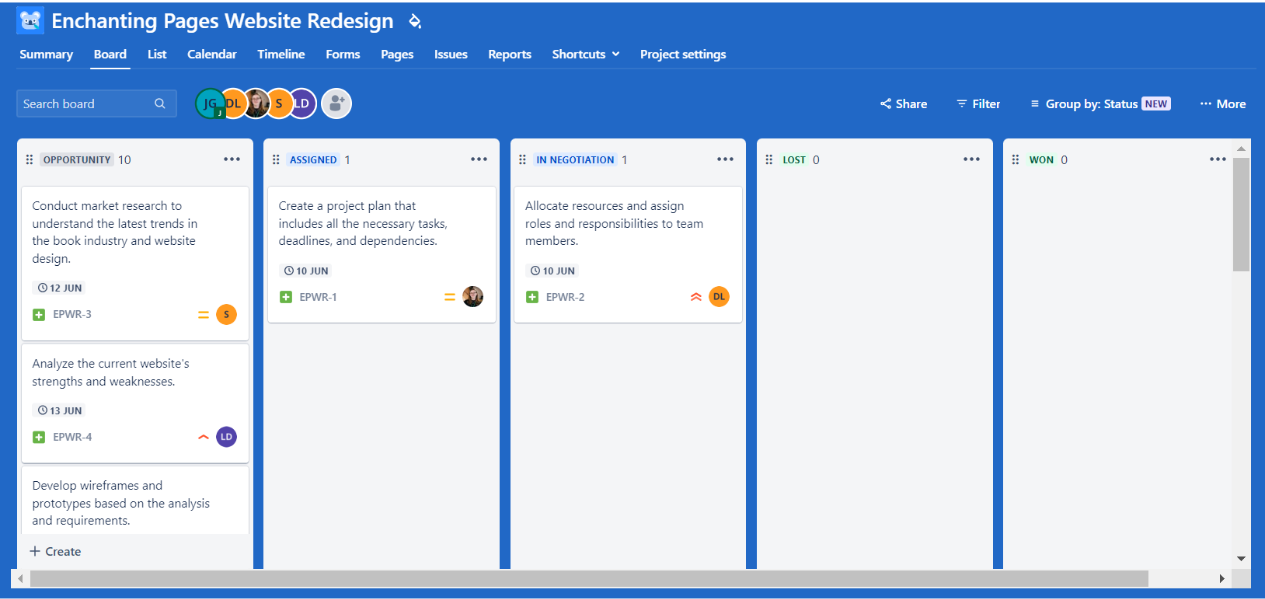
Jira’s Kanban view. Image: Tech.co’s testing process
2. Run a premortem
No matter how hard you try to avoid them, every project carries risks. Whether they be technological, operational, or financial, the unfortunate truth is that a number of factors could derail the development of your project at any moment. While it’s impossible to stamp these threats out entirely – around 65% of workplace projects fail – risk mitigation can be practiced to limit their impact.
One option is to run what’s called a project premortem. This is a process for identifying the potential hazards and their impact before they arise. You work backward from an imagined catastrophe to the steps that could have led to it, so you can prepare to avoid those mistakes. Then, you can determine if it will be of a low, medium, or high priority to monitor various potential turning points and form a plan to mitigate each risk.
By considering problems before they emerge, you can keep nasty surprises to a minimum and tackle them swiftly when they occur.
3. Establish SMART goals
Before you assemble your team and start disseminating tasks, you need to establish your goals. If you’re working with clients or stakeholders, you should consider their demands first. Then, when the project’s final vision becomes clear, you can work backward and determine which tasks are required to help you reach your end result.
When setting goals, you need to make sure they are SMART. SMART goals refer to objectives that are Specific, Measurable, Attainable, Relevant, and Time-bound. By following these metrics when setting your goals, the steps you’ll need to take to reach your targets will become clearer. Not only can this increase your project’s chances of success, it’s also an effective way to make expectations clear from the offset.
4. Set milestones
Once goals have been set, milestones should be next on the agenda. Milestones refer to critical points along a project’s life cycle that separate one phrase from the next. They break down the wider goal into smaller, more manageable achievements and they help to inform the Project Manager (PM), clients, and employees about the project’s progress, along the way.
By establishing defined milestones, managers can easily assess whether a project is on track and if key deliverables – identified in the goal-setting stage – will be met. With this information, they can then make adjustments to the project’s life cycle if necessary.
The nature of project milestones will vary case by case, but common examples include project approval, beginning and end dates of key phases, client and stakeholder approvals, and important internal or external meetings.
Project management tool Teamwork – which scored an impressive 4.6/5 on our last round of testing, coming in second place to monday – has a milestones feature so you can mark down the most important points in your project. Teamwork describes its milestones as “beefed” up tasks with extra features – for example, you can associate a milestone with a group of tasks that have to all be completed by a certain deadline.
5. Don’t skip the detail
There’s no denying it, meticulous project coordination is one of the most crucial elements of project management — but it takes time, and is easy to skimp on. Don’t. Crystallizing your vision into a solid, detailed plan will make it much easier for you to hit your milestones, avoid scope creep, and ultimately, produce the highest quality project possible. A detailed plan can also be used to guide clients and employees through the project’s key stages.
When it comes to working out your plan of action, this isn’t a process that should be rushed. Cutting corners during the planning phase will only come back to haunt you further down the line – this is perhaps the most important project management tip to remember.
Luckily, project management tools like ClickUp – which is our top-rated provider for task management (4.7/5) and collaboration (4.7/5), as well as over functionality (4.6/5) – have precisely the kind of tools required to ensure you’re not missing a beat, be it in the planning phase or beyond.
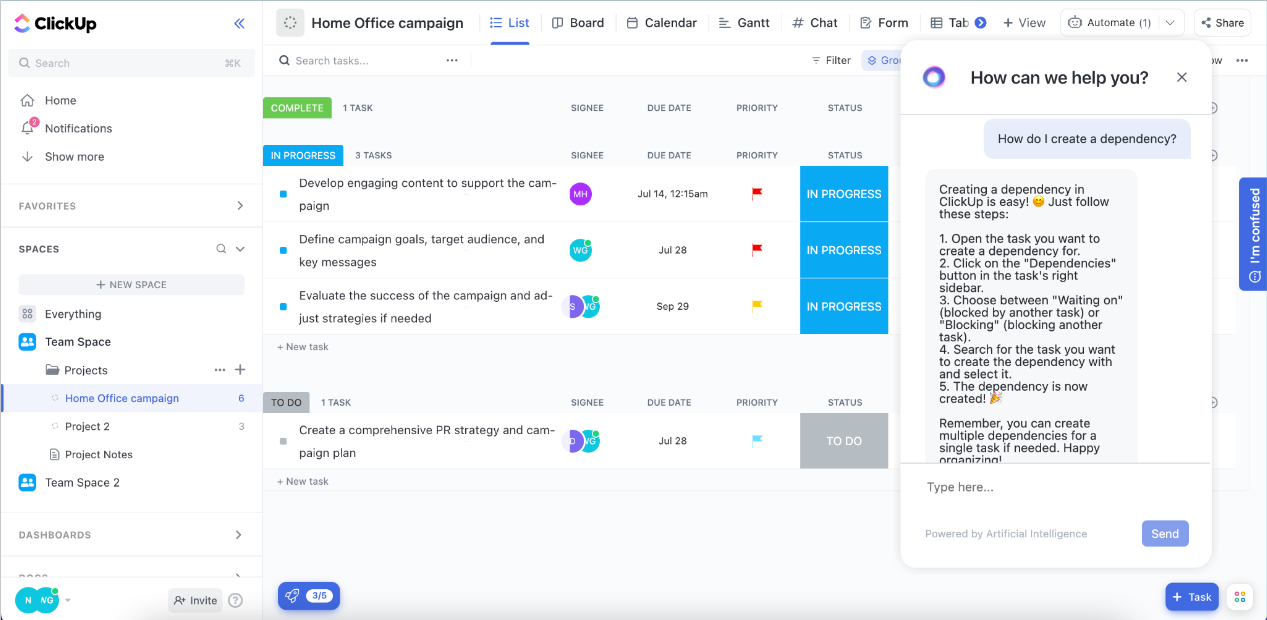
ClickUp’s List view. Image: Tech.co’s testing process
6. Manage your time, ruthlessly
Every project has a timeline. Understandably, the idea of working against a ticking clock can be stressful if you’re new to project managing. However, with effective time management strategies, even the most inexperienced managers can meet all of their deadlines without sacrificing their quality of work.
The key is to prioritize and question your daily activities, ruthlessly. Do you really need to attend that meeting? Is the task you’re focused on now the most important thing you could be working on?
Aside from forming and following a structured and detailed plan, breaking down your workload into smaller, more manageable tasks is a great way to keep the project on schedule. Deconstructing larger deliverables can make it easier to focus on the key steps that matter and prevent you from becoming overwhelmed — a true asset in a role where having a clear head is key.
If you’ve got the budget, software can also help. The right software will enable Project Managers to automate key processes and keep track of their time more effectively. monday is a popular and powerful option, and is actually free for individuals to use. This can be an invaluable way to accelerate your productivity while minimizing project delays.
For more project management tips related to time-tracking, check out our project management skills guide.
7. Trust your team members
When delivering a project, your team is your biggest asset. And, just like in an orchestra, when each individual performs their role correctly, a wider harmony across the team is able to be achieved. Accordingly, to get the most out of your employees, you need to trust their ability to contribute to the success of the project. By doing so, decisions can be made faster, and more responsibilities can be assigned to individuals.
While trust among teams helps to move your project forward, it’s not able to be built overnight. Instead, trust is established over the span of a working relationship. If you’ve worked with your team for a while, this shouldn’t be hard to achieve. If not, you can gain confidence in your team’s abilities through successful role delegation, as we explore next.
If you really can’t trust your team, or a certain member of your team, to produce the work needed from them, it should be addressed as a matter of urgency, or it will hinder the success of the whole project.
8. Delegate!
It’s one thing getting “stuck in” and another to overload yourself with responsibility. No Project Manager should be expected to have all the answers. Therefore, at the beginning stages of a project, assigning clearly defined roles should be very high up on your agenda.
If work isn’t divided in the best way, team members may end up with unfair workloads, too. This will demotivate them and hamper progress, as they struggle to complete their tasks in the given time period. Ultimately, it will waste your company’s valuable time and resources and interrupt the project’s development. What’s more, preventing your workers from showcasing their best soft skills could also weaken levels of trust. To stop this from happening, it’s the project lead’s responsibility to delegate roles and tasks effectively and fairly.
While there’s no foolproof way to do this, we recommend that you make the expectations of the project crystal clear and include staff in the delegation process when possible.
9. Write everything down
Managing a project can often feel like spinning plates. And when you’re juggling multiple tasks at once, it’s easy for important details to get lost along the way. To avoid this from happening, you shouldn’t just rely on your memory.
You should create consistent records of the work being done at all times. From meeting schedules to client feedback, keeping notes will help you gain a clearer overview of the project’s development and it will also help you learn from your previous mistakes if a pursuit doesn’t go according to plan. taking this project management tip too lightly can lead to major confusion.
Of course, you don’t have to do this by hand. Recording discussions or typing notes up digitally is a very effective way to keep important details on hand. Assigning scribe duties to one of your team members is also a useful strategy if you’re too busy to take on this task yourself.
10. Keep your workload organized
Being organized goes hand in hand with being a successful project manager. Without the implementation of an air-tight organization structure, the work of your team can be impeded and in extreme cases, the delivery of the project can fail. This is a fate no project lead wants. So to ensure the success of your project, you need to do what you can to keep your workload as organized as possible.
Fortunately, gone are the days when we needed to rely on manual methods. Project managers can now rely on an array of useful software to organize their tasks, manage their performance, and keep their workflow on track. For example, project management tools by Asana and Monday can help your team to stay organized and connected, even when you’re working on a project remotely.
You can see how the software titans compare here, or check out our review of monday for more information on the provider.
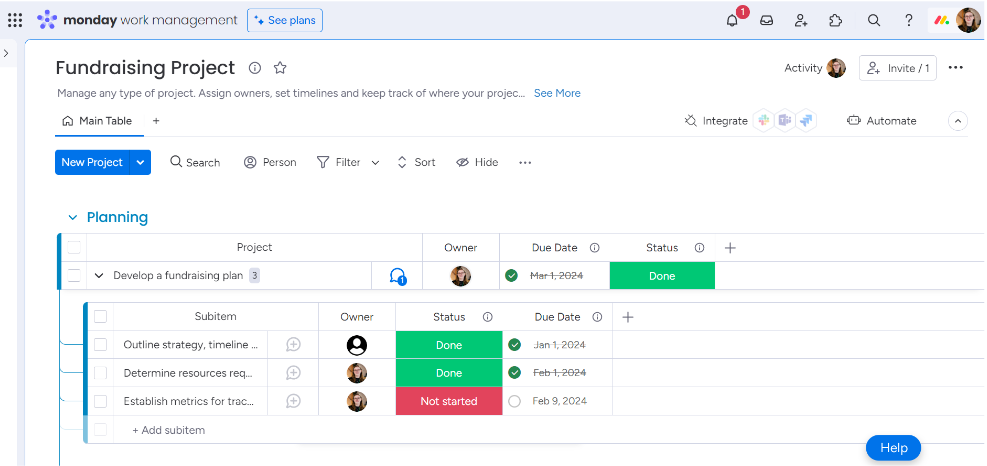
The Main Table view in monday. Image: Tech.co’s testing process.
11. Communicate more than you’d think
Even the smallest of projects contain multiple moving components. To make sure confusion doesn’t derail your development, clear communication needs to become a cornerstone of your project. As i project manager, you’ll likely be on top of all the moving parts on a regular basis, but that doesn’t mean everyone else will be, so you might need to communicate updates more often than you’d naturally think to.
By maintaining clear communication channels across members of your team, clients, and stakeholders, you can ensure that everyone is rallied around the same vision. Not only does this make the shared goals clear, but it also helps employees understand what is expected of them.
If you’re working on-site, it’s advisable to follow up with workers informally and, when possible, schedule catch-up meetings, so they can offer you feedback. Alternatively, if you’re managing fully remote or hybrid employees, communication software, like Zoom, can be used to keep your team connected.
To make sure confusion doesn’t derail your development, clear communication needs to become a cornerstone of your project.
12. Test your deliverables
To make sure your project meets its desired objectives, it’s important to test your deliverables as you go. In project management, a deliverable can refer to any output, be it tangible or intangible. For instance, engineering deliverables could include design drawings and product prototypes, as well as presentations to clients and the final end product. Software deliverables could be certain functionalities created as part of the overall build.
By testing these along the way, you can check if your product or service is functioning (or will function) as it’s intended to. This will help you to monitor the results of your project and keep a document of your progress. What’s more, if your deliverables are consistently being met this will fill your stakeholders with confidence.
13. Learn from other project managers
Topping the chain of command might feel a bit daunting. But it’s important to remember you’re never going through the process alone. No matter the complexity of your project or the industry you work in, there will be countless other project managers who can relate to your experiences – some who will have navigated the path successfully, and some, undoubtedly, who will have been forced to learn from their mistakes.
By reaching out to these project leads, you’ll be able to gain valuable insights into what techniques and processes are required to make a project work. Then, by following their project management tips and sidestepping their pitfalls, you can give your project the best chance of succeeding possible.
If you’re unable to find other project managers within your own business, social media, networking events, and online forums can help.
14. Show empathy while managing
If you want your team to be motivated to work towards a shared goal and invest time and energy into your project, you have to invest time into understanding them as both a team and as individuals. Part of this will be regularly checking in with staff to find out how the part of the project they’re responsible for is going, as well as listening to feedback.
Taking a genuine interest in problems your team members are facing, and ensuring they have everything they need to work to the best of their abilities, will contribute to the creation of a mutually supportive environment where people are more than willing to help their colleagues when the going gets tough.
15. Celebrate your successes
Projects can be hard work for everyone involved. And while the completion of a project can be hugely gratifying in itself, it’s also important to celebrate the team’s collective success along the way.
By rewarding hard work and sharing your triumphs externally, it can motivate your team and improve your company’s reputation. Taking time out of your schedule to unwind and socialize is also a great way to for employees to bond and boost morale — a benefit that can often be translated into future project wins.
Plus, while celebrating shared successes is important, singling out employees who have gone above and beyond is an excellent way to recognize accomplishments and elevate your team members. The nature of these rewards can vary, but common examples include team lunches, employee bonuses, or shout-outs.
Common Project Management Problems and How to Overcome Them
We’ve referenced a couple of project management problems while talking about the project management tips above – so we thought it would be best to look at them a little more closely in this section. After all, the more you know about common problems that project managers face, the more likely you’ll be to spot them in projects of your own.
Scope creep
In a nutshell, scope creep is the unchecked and unsustainable growth of the demands of a project. Sometimes, scope creep can make a project so unmanageable and financially draining that it becomes undeliverable without major changes to resources, schedules, budgets, and deadlines.
Some extremely famous projects – including the construction of the Sydney Opera House – have fallen victim to scope creep. Luckily, that one was completed (eventually) – but don’t underestimate scope creep’s ability to kill off a project.
Breakdown in communication
Communication is everything – and the more people working on your project with you, the harder it is going to be to ensure that everyone is on the same page. If project managers don’t communicate exactly what they expect and what the goals of the project are, it’s likely to lack direction. Those involved aren’t going to feel like they have a common purpose, which is good for projects.
What’s more, teams lacking effective and passionate communicators won’t identify as many problems or capitalize on as many opportunities as collaborative teams constantly discussing one another’s movements.
However, expecting good communication to arise out of thin air will leave people isolated and frustrated. You have to take significant steps to ensure the individuals within your team know who to contact for what. Core to your managers’ duties should be checking in on staff and ensuring they’re in the loop with where the project is at and what still needs to be done.
Good communication is also about respect and ensuring everyone’s voice is heard – and if you’re a project manager, it’s up to you to set the tone. Remote and hybrid workplaces are commonplace and a significant number of people have colleagues living on the other side of the world – so maintaining good communication via digital channels is essential.
Project management tools like Wrike – which scored 4.4/5 according to our latest round of user testing – have built-in collaboration tools like task comments and project message boards to ensure that everyone’s on the same page, wherever they’re working.

Commenting on tasks in Wrike. Image: Tech.co’s testing process
Responding to setbacks poorly
Almost all project managers have an anecdote about a time it seemed like a project they managed was on the brink of collapse. Setbacks can arise out of the blue and demand immediate action to be taken to mitigate their effects.
Rash, ill-thought-out decision-making in the face of a setback can have the capacity to derail a project even more significantly than the initial setback itself. Failing to communicate with your team about the challenges you face – or not approaching problems they’ve raised with sufficient sincerity – will also strain relationships. When faced with tough times, honesty is always the better policy.
If you stay calm, so will your team – and if you show you’re tackling the problem you face head-on, they’ll join you in your efforts. Approached in the right way, however, and with the right attitude, it can be a formative experience that you’ll be able to draw upon when you next a setback in a future project.
Solving project management problems
Don’t worry – the project management tips discussed in this article will help to alleviate many of the above issues, which you may well run into while you deliver your project.
For instance, performing premortems and setting SMART goals can significantly reduce the chances you’ll experience scope creep during your project. If both goals and potential problems are clearly defined and contingency plans made prior to the project commencing, the better chance you’ve got of staying on track once the project is underway.
Calculated, consistent delegation and trusting your team, on the other hand, will help you respond to setbacks in an efficient manner. Knowing you can rely on those around you will help you respond quickly and confidently – regardless of the problem.
Of course, project management software, with its built-in communication tools, common dashboards, and budgeting tools can provide the kind of organization that will help you avoid common project management problems. Asana’s data display tools, for instance, will provide valuable insights you can use to inform your decision-making:
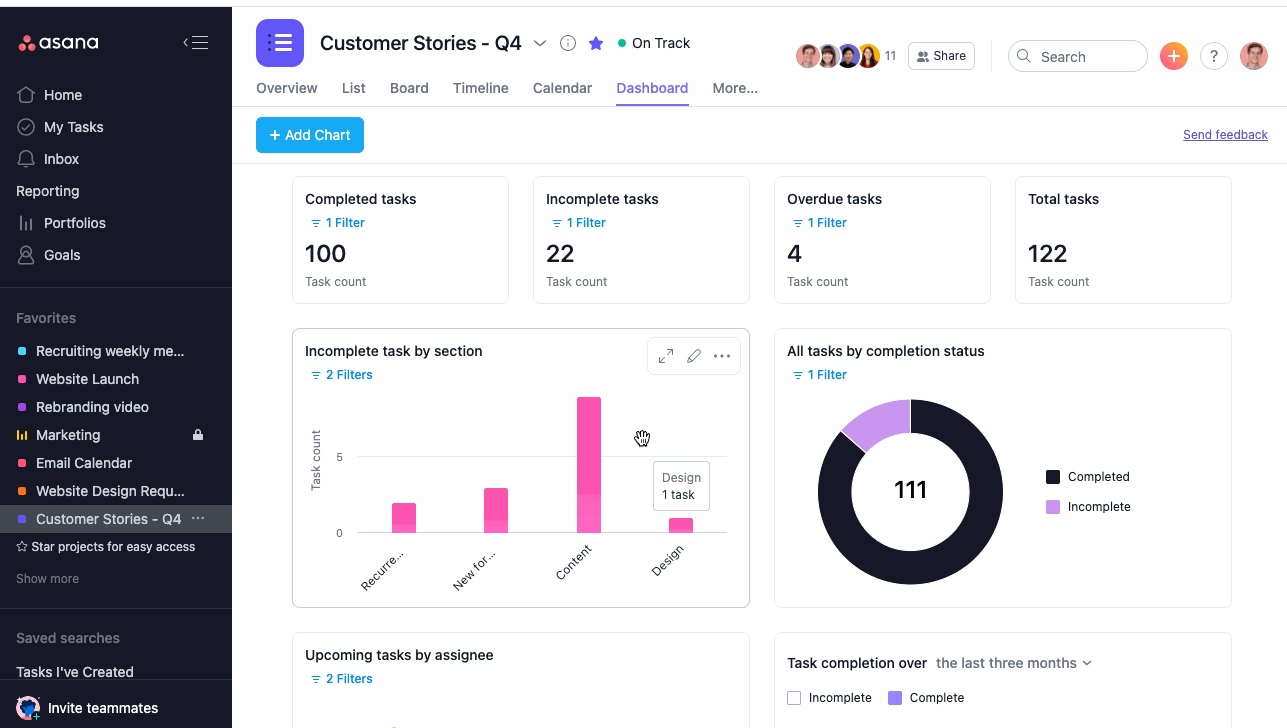
A data dashboard in Asana. Image: Tech.co’s testing process.
The Benefits of Project Management Software
If it’s not already clear by now, technology can be a trusted ally for project managers looking to rise to the top of their domain. When used alongside the project management tips discussed above, project management software has the power to streamline the delivery of your project in more ways than one.
Speedier project roll-out
One major way the software could benefit you is by speeding up the rollout of the project. More often than not, your stakeholders will want to see results as soon as possible. Fortunately, project management software allows managers to keep the process forward flowing by letting them view their projects status in real-time, communicate with team members instantly, and eliminate risks in a timely manner.
Simplified task management
Project management software can also be used to simplify task management. By giving professionals the ability to manage a large and dynamic series of tasks on a single platform, the whole project can be taken care of in a much simpler fashion. Not only does this keep workflows on track, it reduces unnecessary paperwork.
Greater time efficiency
Various pieces of software, like monday, ClickUp, and Asana can help Project Managers to use their time more efficiently. These tools inform users about how much time they spend on different parts of a project by providing them with a timeline of their working day. This can help workers to manage their time more effectively by keeping guesswork to a minimum.
Gantt charts are a great way to get a top-level overview of precisely how much time different tasks or aspects of your project may take, and how they’re going to overlap with one another as you complete the project. Here’s a little look at ClickUp’s:
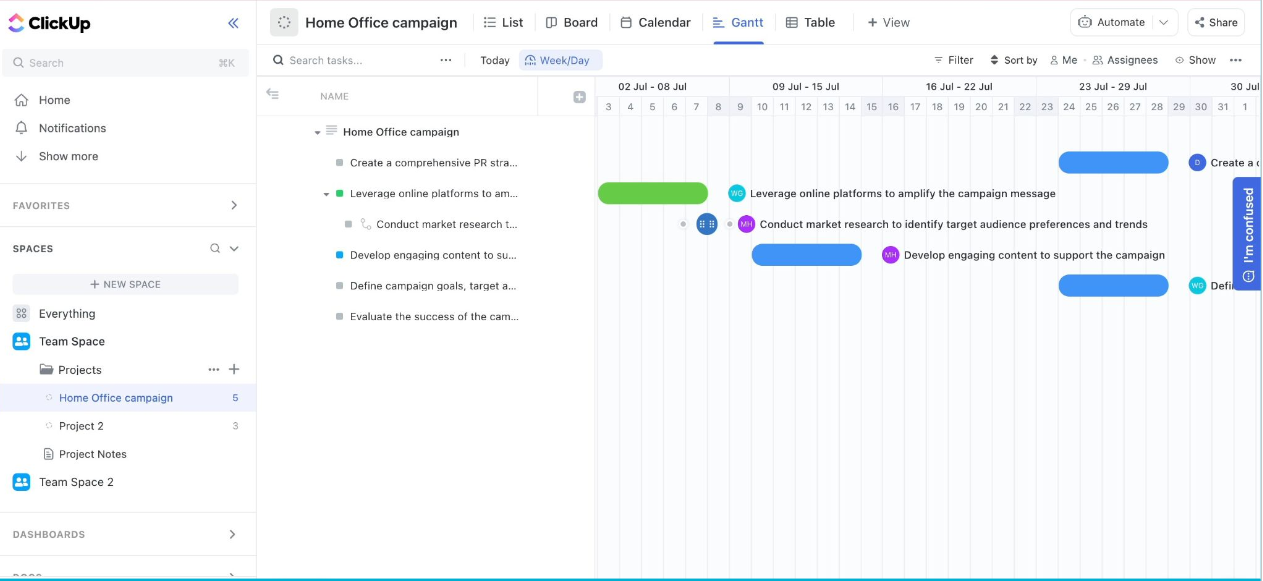
ClickUp’s Gantt chart. Image: Tech.co’s Testing Process:
Automated stakeholder feedback
Finally, in a profession where communication is key, project management software can also benefit project managers by automatically keeping stakeholders in the loop. Specifically, certain feedback tools allow managers to inform stakeholders about the progress of their projects without the need for manual input. Since keeping stakeholders informed is one of the easiest ways to maintain good relations, this software can be an extremely useful tool for PMs.
If you’re looking to leverage project management software but you’re not sure where to start, not to worry. Our latest breakdown of the top project management providers can help you establish which solution might be best for your business. You can see a snapshot of our top picks, in the table below.
| Price from All prices listed as per user, per month (billed annually) | Score The overall score obtained from our most recent round of project management software user testing | Verdict | |||||||
|---|---|---|---|---|---|---|---|---|---|
| Best All Round | Great Value and Excellent Automation Builder | Best For Task Management & Collaborating | |||||||
| 4.7 | 4.6 | 4.5 | 4.5 | 4.4 | 4.3 | 4.2 | 4.1 | 4.0 | 2.9 |
| A great task management system due to strong customizability and support team, with a generous free trial | A great user experience all round, with an easy-to-use automation builder and great budget tracking capabilities | Slick software with a highly powerful core and an AI assistant, plus a genuinely usable free tier for individuals | A simple task-list-based project management platform with an acceptable free tier | A feature-rich service with two plans for enterprises, and a free tier for new users to try | A fairly-priced, stripped-down option, best for small teams who need a central location for basic task management | A great tool for spreadsheet-natives, which can take your Excel-based task planning to the next level | A great value piece of software that’s ideal for tech, software development, and engineering teams | A solid project management solution with an attractive free tier for small teams and a very affordable premium plan | A very basic, relatively limited software that’s a lot simpler than its competitors |
Frequently Asked Questions
If you click on, sign up to a service through, or make a purchase through the links on our site, or use our quotes tool to receive custom pricing for your business needs, we may earn a referral fee from the supplier(s) of the technology you’re interested in. This helps Tech.co to provide free information and reviews, and carries no additional cost to you. Most importantly, it doesn’t affect our editorial impartiality. Ratings and rankings on Tech.co cannot be bought. Our reviews are based on objective research analysis. Rare exceptions to this will be marked clearly as a ‘sponsored’ table column, or explained by a full advertising disclosure on the page, in place of this one. Click to return to top of page










